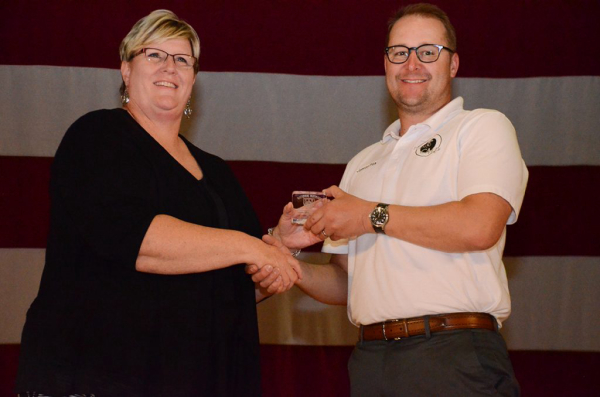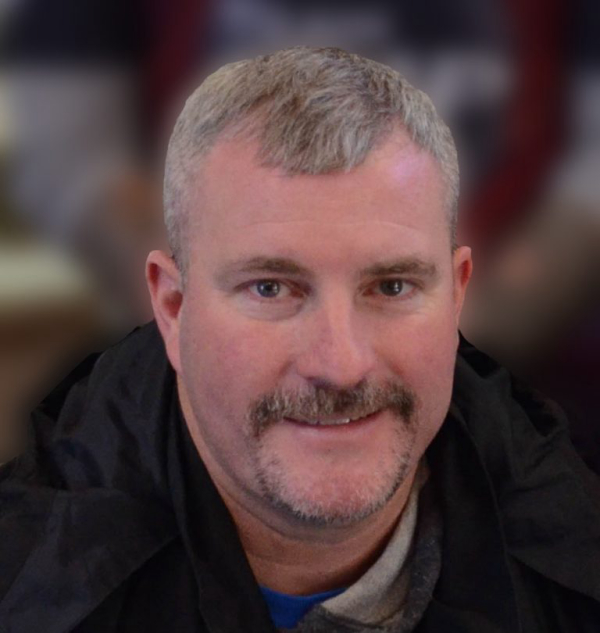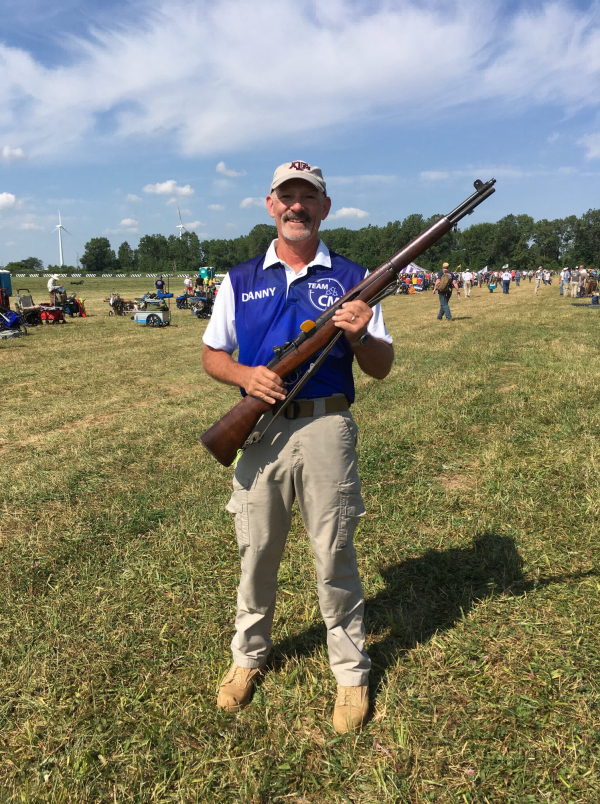(Today's feature is from the Civilian Marksmanship Program.)
When it comes to marksmanship competition, skills can only go so far – having a strong mental game is also a key part of reaching success. In an effort to gain tips on better regulating the psychological aspects of competitive shooting, the Civilian Marksmanship Program (CMP) asked respected athletes to share their personal experiences from the firing line on what they do to control their emotions when nerves creep in and the pressure is high.
James Fox, Team CMP Highpower

James Fox, 35, of Albany, Oregon, earned his Distinguished Rifleman Badge in 2000, the same year he was the Intermediate Junior National Champion, and has reached the classification of High Master. He was also the first junior to win the Erdman Trophy, awarded to the winner of the National Rifle Association’s 200-yard Standing Aggregate.
Continuing his success at the Camp Perry National Matches, James was on the winning Whistler Boy Team (two-person junior team match) in 2001 and in 2002 and went on the latter year to win the Golden Eagle Trophy for High Junior in the NTI, the Pietroforte Trophy as the highest civilian competitor in the NTI, was the Intermediate Junior Service Rifle National Champion, and he qualified for the prestigious President's Rifle Match President’s Hundred.
After an 11-year hiatus, Fox returned to marksmanship in 2017. Last year’s National Matches saw Fox earning the Alice Bull Trophy as the high scorer of the President’s Rifle and NTI aggregate, the Pershing Trophy as the high individual of the National Trophy Team (NTT) match, the Pietroforte Trophy, the Mountain Man Trophy (with the highest aggregate score in the President’s, NTI and NTT matches), among several other notable performances throughout the event.
“Pressure is something that I think all shooters will experience at different times in their shooting career, and how they handle that pressure will differentiate them from the rest.
Arguably, I think the best way to prepare for pressure is to constantly train under pressure. This will help normalize the pressure you are feeling, and, therefore, reduce the impact it has on your performance. This is why when people ask me if I feel any pressure during a shoot-off, the answer is no. I have been in enough shoot-offs now that it feels like any other stage of a match, and, therefore, the pressure does not get to me.
So, when you are at a local match or practice, set a goal for yourself that puts you under pressure. Or, better yet, plan some friendly competition with someone that is close but just above your skill level. This should help replicate what you might experience in a big match. Over time, as you shoot more, pressure will be something you feel less and less.
That said, pressure will never go away entirely. I still feel it in really big matches.
I do the following to help reduce any pressure I might feel at a big match: have fun and relax.
Anyone that has interacted with me on the firing line will know that I like to joke around. The reason I am doing this is to help prevent from dwelling on my goals or the pressure I might feel at that match. By not constantly thinking about the items that increase the pressure I am under, it helps keep me calm for longer, and, thus, reduces the cumulative effect that pressure and stress has on the human body.
Now, I am not advocating that you must never think about what you need to do to perform at the best of your abilities, but, rather, constantly thinking about those things does not help. Try to clear your mind of all thoughts before starting to shoot your stage. Although I have never meditated, I presume that this is what meditation is like.
Leading up to the start of a stage, I will clear my mind and just think about the steps I need to take to execute a shot. So, I suggest that for people that have problems clearing their mind, try practicing meditation to help aid in this ability.
Make the pressure hone your performance.
I feel that, most of the time, being under pressure improves my performance. It prevents me from being lazy in my shooting and forces me to be at the top of my game by focusing on exactly what I need to do to shoot the best scores.
In one of Oregon's state championships I shot in, the person scoring me shot a 200 with a good X-count in rapid sitting and was leading the stage. After my first string, I had to shoot a 9X clean or better to win the stage. The scorekeeper remarked, "Now we will see how you perform under pressure." I used that pressure to focus and went on to shoot a 9X clean to win the stage.
Lie to yourself.
Pressure sometimes gets to me despite everything. In those cases, it will increase my heart rate and blood pressure, which is not ideal.
This was the case in the six-man team match at the 2019 CMP National Championships at Camp Perry. I was right at the top when it came to the contenders for the Mountain Man Trophy, which I had set as a goal to win that year. That last day, despite normally being able to clear my mind of all thoughts, I was not able to keep the knowledge of potentially being able to win that aggregate out of my mind. It just kept creeping in.
I remember hearing that if you tell a lie long enough, eventually you will start believing it. So, I started lying to myself, after dropping one point in standing that day, and started repeating over and over in my mind that the possibility of winning was over for me. That constant lie helped reduce the pressure of winning and helped reduce my heart rate. I consequently then went on to be the top shooter of the day, winning the Mountain Man Trophy.”
Robert Taylor, Team CMP Highpower

Robert Taylor, 41, of Sonora, California, has been a marksmanship competitor for almost 30 years. He earned his Distinguished Rifleman Badge in 1997, when he also earned a High Master Classification. He was a firing member of the winning Junior Minuteman Trophy Team in 1998 and also a member of the 1998-1999 winning Whistler Boy Trophy team. He’s an 11-time member of the President’s Hundred, finishing as high as third place overall. He has been the coach of the junior highpower team, the California Grizzlies, since 2000, and has led several of its members to multiple Distinguished Badges, National Records and Nationals Trophies, including the only junior team to have ever won the National Infantry Team event in 2009. Currently, he is a member of the Coalinga Rifle Team from California.
“It’s never been easy dealing with pressure. I have found over the years in numerous competitions how easy it is to let the moment get away from you with what you should be doing and start thinking about the outcome rather than the performance. Here are four things that I focus on.
1. Mental Rehearsal:
Mental rehearsal, for me, is key. It starts months ahead of a big competition and continues up to weeks, days, hours and moments before I execute the day’s shots down range. I will mentally rehearse the event dozens of times in my mind with the way that I want to perform. I also like to mentally go through any possible situations that might arise so as not to get caught off guard.
2. Relaxation and Breathing:
If you’re uptight and stressed out, it’s not “if” but “when” is it going to affect your performance.
I know we all have done this and observed this over time from – shooting a crossfire, somebody shooting a shot on your target, shooting a miss and missing the wind – the list could go on and on. But, I want you to stop and think about how many times you have observed someone lose their composure because of one of these situations. In fact, I bet if you’re honest with yourself, you have done this. You need to find something to think about that gives you instant relaxation. Vacation, your significant other or your kids – everyone has a thought that gives them relaxation. You must also learn to always be breathing. You can avoid a lot of stress in your performance by having a steady breathing regimen.
3. Staying In Your Comfort Zone:
We are all guilty of not staying in our comfort zone. It’s critical to stay in your comfort zone mentally when you’re performing. For example: If you’re a 460-average shooter and you’re going into a big match hoping to shoot a 480, odds are you will stress yourself out and your performance will look more like a 440 – leaving you very stressed and disappointed. Practice and local competitions are when you should be working on increasing your comfort zone from 460 to 465, 465 to 470, and so on until you have reached your desired score.
4. Perfect Practice:
When I grew up, I remember people telling me, “Practice makes perfect.” If only that were true. Only “perfect practice” makes perfect. In order to shoot shots in the middle, you have to practice shooting shots in the middle!
In closing, it’s not the quantity of reps (physical and mental) but the quality that you should aspire for each and every time you take the time to work on your next performance! I hope this might help those of you who are trying to get over that mental hump in your preferred shooting discipline.”
Danny Arnold, Team CMP Highpower

Danny Arnold, 55, of Clayton, Texas, has been a Distinguished Rifleman since 1996 and holds the High Master classification. A member of Team CMP Highpower, Arnold can also be found calling matches at some of CMP’s Travel Games and the CMP Long Range events during the National Matches at Camp Perry. He began his marksmanship career with the University of Oklahoma Smallbore Rifle Team, a member from 1986 to 1988. His transition into highpower started in 1989 with a match rifle.
Since then, he has made the prestigious President’s Hundred (a celebrated mark for the top 100 scorers of the President’s Rifle event at the National Matches) seven times, with one Top 20 finish, and has accrued state and regional championship wins. He even made the honorary Elihu Root National Civilian Rifle Team in 2014, which recognizes the six highest scoring civilian competitors of the National Matches. He’s a part of the NRA’s 495 Club and has also been a member of trophy-earning teams during the National Matches.
“Handling Pressure – there’s been more than a few books written on the subject, but I’ll give it a shot.
I break pressure down into two sources: External and Internal.
External Pressure is caused by all the things in your environment that upset your mental processes. Luckily, much of that can be controlled through preparation and routine.
An example of a technique to control External Pressure is very basic: Load all of your magazines and your offhand ammunition carrier the night before the match. On the day of the match, this allows you more time to mentally prepare instead of using that time to load magazines.
Another technique that I use is to practice like I will be shooting at Camp Perry’s National Matches. Each stage of the match has clearly defined time limits. First, there is a command to “Bring your gear to the line. Your Preparation Period will begin in two minutes.” That is followed by a three-minute Preparation Period. Firing starts immediately thereafter. I practice with a three-minute Preparation Period so that I’m used to getting my buckles tightened, finding my NPA and dry-firing a few times within that three-minute time frame.
Most local matches are not as structured as the National Matches, and competitors get used to longer preparation periods, unhurried relay changes and untimed brass calls. When they go to Camp Perry, many are rattled by the difference, where they feel pressured and lose mental focus. When I practice, either dry-firing or live-firing at the range, I also hold myself to strict time limits: 10 shots in eight to eight-and-a-half minutes, or 22 shots in 18 minutes for offhand. That ingrains a natural pace that gives me just a little extra time, should I have to wait for wind gusts, slow pit service, etc.
This sounds ridiculously simple, but being a little early and at the right place goes a long way toward eliminating pressure at a match.
To summarize: External Pressure is environmental and can be controlled through preparation and routine.
Internal Pressure is the pressure that you put on yourself: the desire to do well, to not let the team down or to not shoot a bad shot. There are a lot of things in the human mind that we either want to do or want to avoid. All of those things can contribute to feelings of pressure throughout a match.
First off, everyone has a bad shot, a bad string, a bad match and, sometimes, just a really bad day. As a good friend used to say, “Build a bridge…and then get over it.” Carrying a bad shot around in your head for the rest of the match doesn’t do your total score any good.
Remember, no one else at the match cares about how you’re shooting. They’re all totally concentrating on how they are shooting. If they’re not, they probably aren’t doing very well. Conversely, you shouldn’t be concerned with how anyone else is shooting. You’ll find out when the scoreboard goes up at the end of the match. Until then, it’s anybody’s match to win or lose.
Have a sense of humor. You got into the game because it was fun, so try to keep it that way. When I shoot a bad shot, more than likely I’ll turn to my scorekeeper and say “Woops!” Whoever is keeping score usually grins and nods because they’ve been there too. I know I blew the shot, the scorekeeper knows I blew the shot, and that shot is now safely out of my consciousness.
What do I do to minimize my own Internal Pressures?
First, I view Internal Pressure as decreasing throughout the match in direct correlation to the stages we shoot. Standing is hardest, followed by sitting rapid, prone rapid and prone slow-fire, assuming that your wind calls are good.
Standing presents a double-whammy: It’s usually the first stage that you shoot, so you’re full of energy, maybe stiff from driving or a sub-par bed, and it’s also the least stable. On the plus side, it’s the biggest target because the 10-ring spans over three MOA, and with optics, it’s also the easiest to see.
To remain calm during the standing phase of a match, I concentrate on what shooting a 10 actually looks like: It’s like a little movie where the reticle crosses into the 10-ring and then oscillates until the shot breaks. I try to keep the movie playing until I load a round and shoulder the rifle. I take up the trigger’s first stage as the reticle is coming into the black, and when what I see in the scope agrees with the movie I’ve been playing in my mind, I pull through the second stage. The movie starts up again when I set the rifle on my stool.
When the process is working, I’m cognizant of the target going down, verifying if the shot was on call and that the scorekeeper has acknowledged the shot, but I have little awareness of the shooting or anything else around me.
For me, playing “The Movie,” keeps my mind focused on the task at hand and pushes everything else out. If something happens to interrupt that, like a competitor loudly lamenting his shot, or one of those random thoughts like, “Did I close the garage door when I left?” – it’s time to get my finger off the trigger and start the process over.
Obviously, I don’t shoot 10’s all the time. If I did, the game wouldn’t be nearly as interesting. Invariably, a few nine’s creep in during the string: Whether it’s on call or not, I own it. The important thing is not to let it ruin the rest of the string or the day. Also, I try to never count points, as in “I’m down 10 points and I can only drop two more if I want to…” That’s a great way to put a lot of pressure on yourself. Instead, I concentrate on putting every shot for the rest of the day into the 10-ring. The X’s will take care of themselves.
-- Ashley Brugnone, CMP Staff Writer
The Civilian Marksmanship Program is a federally chartered 501 (c) (3) non-profit corporation. It is dedicated to firearm safety and marksmanship training and to the promotion of marksmanship competition for citizens of the United States. For more information about the CMP and its programs, log onto www.TheCMP.org.
